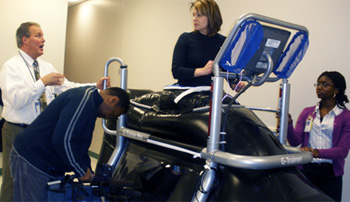 |
KETV Channel 7’s Julie Cornell tested the treadmill for her story that aired on Sunday, Feb. 7. |
What do two NBA superstars have in common with a 17-year-old senior at Omaha South High School?
All have trained on the NASA-developed Alter-G anti-gravity treadmill, though for different reasons.
Athletes typically use the $75,000 piece of exercise equipment to run at a fraction of their body weight after an injury or surgery. It permits them to workout yet minimizes stress and impact on joints and muscles.
Ondracek, who has cerebral palsy, used it to help her walk for the first time in four years.
|
Ondracek was part of a bodyweight suspension research study at the UNMC Munroe-Meyer Institute (MMI) conducted by Max Kurz, Ph.D., director of biomechanics at MMI; Wayne Stuberg, Ph.D., director of physical therapy at MMI; and physical therapists Brad Corr and Nina Smith. Alter-G Inc funded the project.
“The Alter-G is used by NASA to reintroduce astronauts to gravitational force,” Dr. Kurz said. “I saw an opportunity to use it as a rehabilitation application.”
At first, Ondracek could only walk for three minutes on the treadmill before tiring. Now, she strides out for 30 minutes and shows off with “no hands.”
All five participants in Dr. Kurz’s study show improved walking and stride length.
Part two of the study will involve brain imaging during walking. Dr. Kurz wants to see what neuroplastic changes take place in the area of the brain that controls movement.